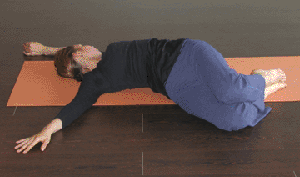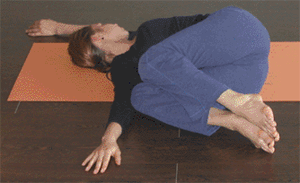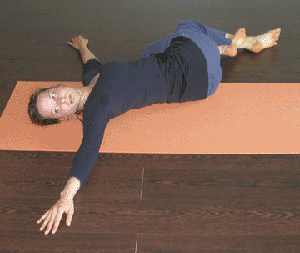

- Twisting at the end of the practice helps to restore equilibrium in the nervous system and release tension in the spine.
- Sarah Powers notes that bringing the bent knee more to the chest can relieve sciatica.
- Massages the stomach and cures gastritis.


- If you have shoulder issues (such as rotator cuff injuries) or are prone to tingling in the hands when you extend your arms overhead, you may not want to raise your arm to rest beside the ear or to let it float. Instead, bend the raised arm or support it with a bolster. If tingling persists, draw the hand lower or rest it on the ribs.
Getting Into the Pose:
- Lying on your back, draw both knees into your chest. Open your arms to the side like wings and drop the knees to one side.


- Directing the knees lower, or higher, will affect where in the spine the stretch is felt. If the knees are higher, this moves the twist to the upper back; lowering the knees moves the twist more to the lumbar/sacrum.
- For a deeper twist, draw one knee into the chest and, holding that knee with the opposite hand, draw it across the body. Rock back and forth a few times, but try to keep the shoulder blades flat on the floor. If the shoulder is off the floor, place a bolster under the bent knee(s).


- If the shoulder is still floating, place a blanket under the shoulder or a bolster along the spine.
- Experiment with the head turning your head to either side and notice how the sensations change.
- The hand alongside the ear can be resting on the floor or on a bolster.
- Try the Twisted Roots pose with knees crossed as in eagle pose (Garudasana).


- Placing the top leg straight out to the side applies the most leverage, which helps to keep the hips fully turned. For some, it’s less of a twist and more of a stretch to the outside of the leg and hip: great for the IT band. The deepest version of this option is to hold the foot with the opposite hand.
Coming Out of the Pose:
- Slowly roll onto your back and hug the knees into the chest to release the sacrum and lumbar.
Counter poses:
- Hug the knees and rock on your back from side to side


- Windshield Wipers while lying back can be a nice release. Lying down with your knees bent and your feet on the floor as wide apart as the mat, drop the knees from side to side.
Meridians & Organs Affected:
- Twisting the spine stimulates the Urinary Bladder lines along the spine (the ida and pingala nadis)
- If one arm is overhead, several meridians in the arms are stimulated – the Heart, Lung, and Small Intestines.


- Twists compress the stomach and massage the internal organs. Twisting through the rib cage stimulates the Gall Bladder meridians.
- Helps the liver, spleen, and pancreas [1]
Joints Affected:
- Nurtures the shoulder joint and upper spine, as well as all the tissues in the upper chest, breast, and shoulder.
- When the knee is at 90 degrees or less, the lower spine, especially the lumbar and sacroiliac joints are stressed.
Recommended Hold Time:
- Three to five minutes.
Similar Yang Asanas:
- Jatharaparivartanasana.
Other Notes:
- An excellent final pose of the practice, because it removes any kinks and knots
- You can slide right from this pose into Shavasana.
- If tingling occurs in the arms or hands, move them lower until the blood flows again. [2]
- Twisted Roots is a great way to internally rotate the hips after a lot of external hip rotation work, such as Shoelace, Swan, Square or Winged Dragon poses.
- Don’t push into the twist, relax. Let gravity do the work.
The above video is an extract from Using Props in Yin Yoga,
which is a 50-minute video.
which is a 50-minute video.


